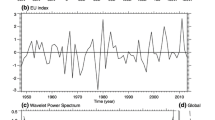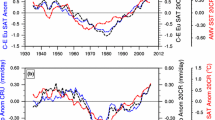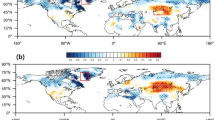Abstract
During the 2022 summer season, parts of Western Europe experienced record-breaking high temperature and drought conditions that had negative societal impacts. To enhance the predictability of regional temperature variability in Western Europe, we regionalized summer temperature and defined the distinct large-scale features of the anomaly fields driving cold and warm regimes at the temperature coherent regions over the land. Our results showed that while temperature anomalies in Western Europe exhibit spatial variability, cold and warm regimes are spatially coherent across landmass where the regional climates respond coherently to large-scale atmospheric circulations. Generally, warm regimes were triggered by horizontal pressure gradients associated with warm advection, by southerly winds. The dominance of cyclonic circulation over the North Sea and anticyclonic circulation over the Mediterranean results in enhanced warm air advection by southwest winds into most of the land in Western Europe. Meridional pressure gradient over the North Atlantic Ocean, resulting in the dominance of southerly winds over the North Atlantic corresponds with positive temperature anomaly over Portugal and western Spain. The dominance of anticyclonic ridge from the North Sea to the Baltic Sea corresponds with above-average temperatures over the United Kingdom and Western France. Moreover, different teleconnection patterns such as the Indian Ocean dipole, Atlantic Multidecadal Oscillation, North Atlantic Oscillation and the Western Pacific Index are distinctively related to the summer temperature variability patterns. During the 2022 summer extreme temperature event, our results indicated above average increase in the amplitude of the circulations associated with warm regimes over the Western European landmass.





Similar content being viewed by others
Data availability
The CRU data is available at https://crudata.uea.ac.uk/cru/data/hrg/. The NCEP-NCAR reanalysis and CPC precipitation data sets are available at https://psl.noaa.gov/data/gridded/data.ncep.reanalysis.html.
Code availability
R studio was used for coding the methods as described in the methodology section.
References
Adams RE, Lee CC, Smith ET, Sheridan SC (2020) The relationship between atmospheric circulation patterns and extreme temperature events in North America. Int J Climatol 41:92–103
Alimonti G, Mariani L, Prodi F et al (2022) A critical assessment of extreme events trends in times of global warming. Eur Phys J plus 137:112
Bador M, Terray L, Boe J, Somot S, Alias A, Gibelin A, Dubuisson B (2017) Future summer mega-heatwave and record-breaking temperatures in a warmer France climate. Environ Res Lett 12:074025. https://doi.org/10.1088/1748-9326/aa751c
Barriopedro D, Fischer EM, Luterbacher J, Trigo RM, García-Herrera R (2011) The hot summer of 2010: redrawing the temperature record map of Europe. Science 332:220–224
Behera S, Ratnam JV, Masumoto Y et al (2013) Origin of extreme summers in Europe: the Indo-Pacific connection. Clim Dyn 41:663–676
Carvalho MJ, Melo-Gonçalves P, Teixeira JC, Rocha A (2016) Regionalization of Europe based on a K-means cluster analysis of the climate change of temperatures and precipitation, physics and chemistry of the earth, Parts A/B/C
Della-Marta PM et al (2007) Summer heat waves over western Europe 1880–2003, their relationship to large-scale forcings and predictability. Clim Dyn 29:251–275
Dong B, Sutton R, Shaffrey L, Wilcox L (2016) The 2015 European Heat Wave. Bull Am Meteorol Soc 97:S57–S62
ECMWF (2022) https://www.ecmwf.int/en/about/media-centre/news/2022/european-heatwaves-june-2022. Accessed 1 Oct 2022
Fan Y, Van den Dool H (2008) A global monthly land surface air temperature analysis for 1948–present. J Geophys Res Atmos 113(D1)
García-Herrera R, Díaz J, Trigo RM, Luterbacher J, Fischer EM (2010) A review of the European Summer Heat Wave of 2003. Crit Rev Environ Sci Technol 40:267–306
Gouveia C, Bistinas I, Liberato M, Bastos A, Koutsias N, Trigo R (2016) The outstanding synergy between drought, heatwaves and fuel on the 2007 Southern Greece exceptional fire season. Agric for Meteorol 218–219:135–145
Harris I, Osborn TJ, Jones P, Lister D (2020) Version 4 of the CRU TS monthly high-resolution gridded multivariate climate dataset. Scientific data 7:109. https://doi.org/10.1038/s41597-020-0453-3
Henley J, Chrisafis A, Jones S (2019) France records all-time highest temperature of 45.9°C. The Guardian, 28 Jun 2019. Accessed 31 Dec 2020
Horton DE et al (2015) Contribution of changes in atmospheric circulation patterns to extreme temperature trends. Nature 522:465–469
Ibebuchi CC, Schönbein D, Paeth H (2022) On the added value of statistical post-processing of regional climate models to identify homogeneous patterns of summer rainfall anomalies in ermany. Clim Dyn 59:2769–2783
Ionita M, Nagavciuc V (2020) Forecasting low flow conditions months in advance through teleconnection patterns, with a special focus on summer 2018. Sci Rep 10:1–12
Jones PD, Lister DH (2009) The urban heat island in Central London and urban-related warming trends in Central London since 1900. Weather 64:323–327
Kalnay E et al (1996) The NCEP/NCAR 40-year reanalysis project. Bull Am Meteorol Soc 77(3):437–472
Kornhuber K, Petoukhov V, Petri S, Rahmstorf S, Coumou D (2017) Evidence for wave resonance as a key mechanism for generating high-amplitude quasi-stationary waves in boreal summer. Clim Dyn 49:1961–1979
Kueh MT, Lin CY (2020) The 2018 summer heatwaves over northwestern Europe and its extended-range prediction. Sci Rep 10:19283
Lee CC, Sheridan SC, Lin S (2012) Relating weather types to asthma-related hospital admissions in New York State. EcoHealth 9:427–439
Mecking JV, Drijfhout SS, Hirschi JJ, Blaker AT (2019) Ocean and atmosphere influence on the 2015 European heatwave. Environ Res Lett 14:114035
Muñoz-Díaz D, Rodrigo FS (2005) Influence of the El Niño-Southern Oscillation on the probability of dry and wet seasons in Spain. Clim Res 30:1–12
Pfahl S, Wernli H (2012) Quantifying the relevance of atmospheric blocking for co-located temperature extremes in the Northern Hemisphere on (sub-) daily time scale. Geophys Res Lett
Philipona R, Behrens K, Ruckstuhl C (2009) How declining aerosols and rising greenhouse gases forced rapid warming in Europe since the 1980s. Geophys Res Lett 36:L02806
Richman MB (1986) Rotation of principal components. J Climatol 3:293–335
Richman MB, Lamb PJ (1985) Climatic pattern analysis of three-and seven-day summer rainfall in the central United States: some methodological considerations and a regionalization. J Appl Meteorol Climatol 24:1325–343
Robine J-M et al (2008) Death toll exceeded 70,000 in Europe during the summer of 2003. C R Biol 331:171–178
Sánchez-Benítez A, García-Herrera R, Barriopedro D, Sousa PM, Trigo RM (2017) June 2017: the earliest European summer mega-heatwave of reanalysis period. Geophys Res Lett 45:1955–1962
Seneviratne SI, Corti T et al (2010) Investigating soil moisture–climate interactions in a changing climate: a review. Earth Sci Rev 99(3-4):125–161
Sheridan SC, Dixon PG (2017) Spatiotemporal trends in human vulnerability and adaptation to heat across the United States. Anthropocene 20:61–73
Sheridan SC, Lee CC (2018) Temporal trends in absolute and relative extreme temperature events across North America. J Geophys Res Atmos 123:11–889
Sousa PM, Barriopedro D, García-Herrera R et al (2020) Distinct influences of large-scale circulation and regional feedbacks in two exceptional 2019 European heatwaves. Commun Earth Environ 1:48
Sousa PM, Trigo RM, Barriopedro D, Soares PM, Santos JA (2018) European temperature responses to blocking and ridge regional patterns. Clim Dyn 50:457–477
Stéfanon M, D’Andrea F, Drobinski P (2012) Heatwave classification over Europe and the Mediterranean region. Environ Res Lett 7(1):014023
Sutton RT, Hodson DLR (2005) Atlantic Ocean forcing of North American and European summer climate. Science 309:115–118
Tanarhte M, Hadjinicolaou P, Lelieveld J (2012) Intercomparison of temperature and precipitation data sets based on observations in the Mediterranean and the Middle East. J Geophys Res Atmos 117:D12
Taubenböck H, Esch T, Roth A (2006) An urban classification approach based on an object-oriented analysis of high resolution satellite imagery for a spatial structuring within urban areas. In: Proceedings on CD-ROM
Toreti A, Bavera D, Acosta Navarro J et al (2022) Drought in Europe August 2022. Publications Office of the European Union, Luxembourg
Trigo RM, DaCamara CC (2000) Circulation weather types and their influence on the precipitation regime in Portugal. Int J Climatol 20:1559–1581
Vogel MM, Orth R, Cheruy F, Hagemann S, Lorenz R, van den Hurk BJ, Seneviratne C (2017) Regional amplification of projected changes in extreme temperatures strongly controlled by soil moisture-temperature feedbacks. Geophys Res Lett 44:1511–1519
Wehrli K, Guillod BP, Hauser M, Leclair M, Seneviratne SI (2019) Identifying key driving processes of major recent heat waves. J Geophy Res Atmos 124:11746–11765
White D, Richman M, Yarnal B (1991) Climate regionalization and rotation of principal components. Int J Climatol 11:1–25
Zampieri M, Toreti A, Schindler A, Scoccimarro E, Gualdi S (2017) Atlantic multi-decadal oscillation influence on weather regimes over Europe and the Mediterranean in spring and summer. Glob Planet Change 151:92–100
Zhang R, Sun C, Zhu J, Zhang R, Li W (2020) Increased European heat waves in recent decades in response to shrinking Arctic sea ice and Eurasian snow cover. Npj Clim Atmos Sci 31(3):1–9
Funding
This research received no specific grant from any funding agency in the public, commercial, or not-for-profit sectors.
Author information
Authors and Affiliations
Corresponding author
Ethics declarations
Conflict of interest
There are no conflicts of interest in this paper.
Ethics approval
No human subject is involved in this study and Figures belong to the author. The paper is also not under consideration in any Journal. There is also no conflict of interest in this paper.
Consent to participate
No human research is used. The authors consent this paper to be considered.
Consent for publication
The authors consent this paper to be published.
Additional information
Publisher's Note
Springer Nature remains neutral with regard to jurisdictional claims in published maps and institutional affiliations.
Appendix
Appendix
Temperature anomaly composites of the CTs in Fig. 6 during the summer season. Anomaly is calculated with respect to the 1981–2010 climatology
Same as Fig. 7 but for the thickness anomaly composites. Thickness is calculated as the difference between the 850 hPa and 1000 hPa height
Rights and permissions
Springer Nature or its licensor (e.g. a society or other partner) holds exclusive rights to this article under a publishing agreement with the author(s) or other rightsholder(s); author self-archiving of the accepted manuscript version of this article is solely governed by the terms of such publishing agreement and applicable law.
About this article
Cite this article
Ibebuchi, C.C., Abu, IO. Characterization of temperature regimes in Western Europe, as regards the summer 2022 Western European heat wave. Clim Dyn 61, 3707–3720 (2023). https://doi.org/10.1007/s00382-023-06760-4
Received:
Accepted:
Published:
Issue Date:
DOI: https://doi.org/10.1007/s00382-023-06760-4








